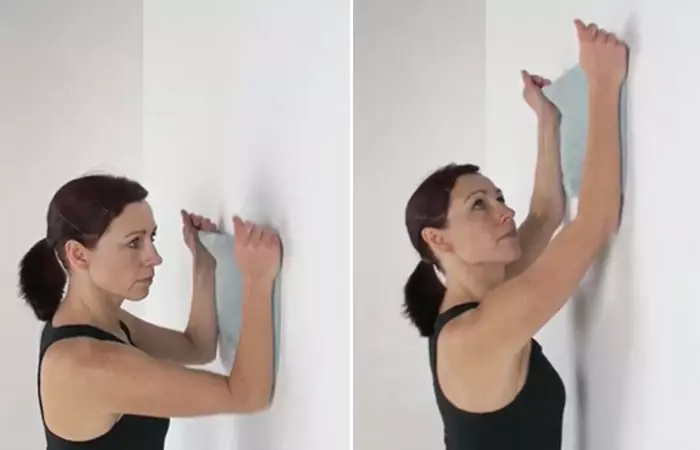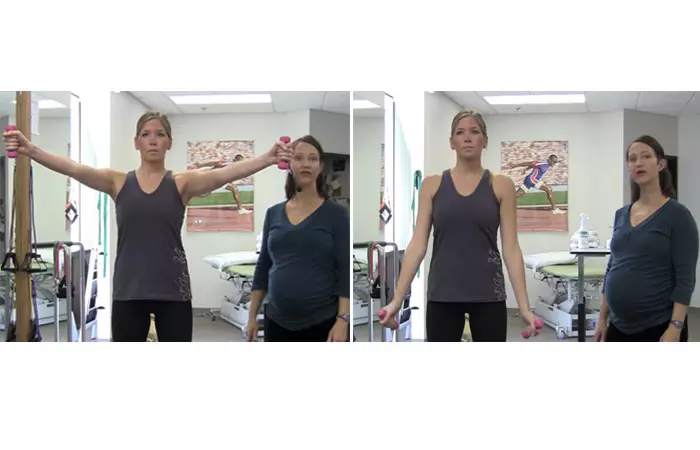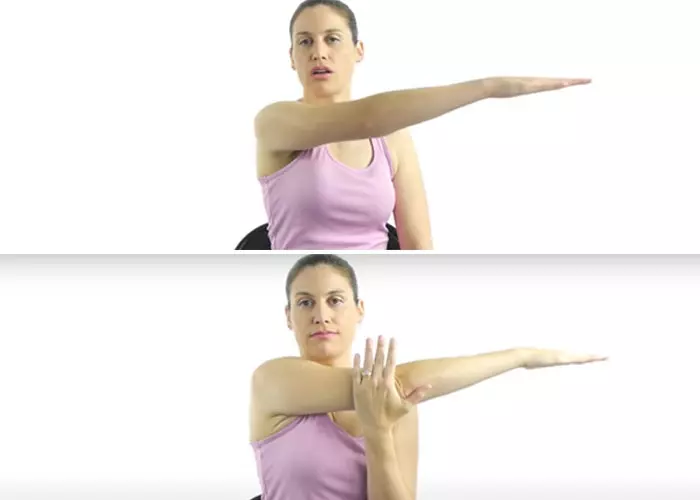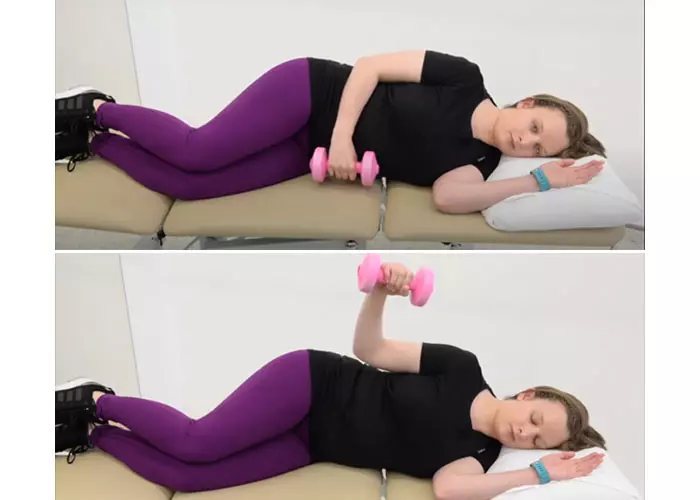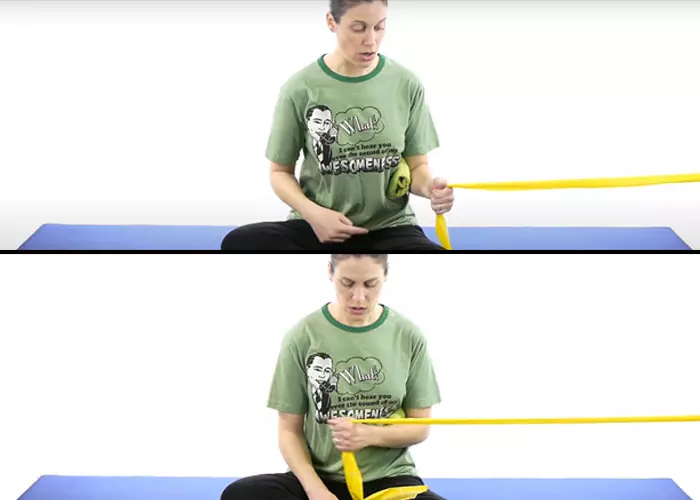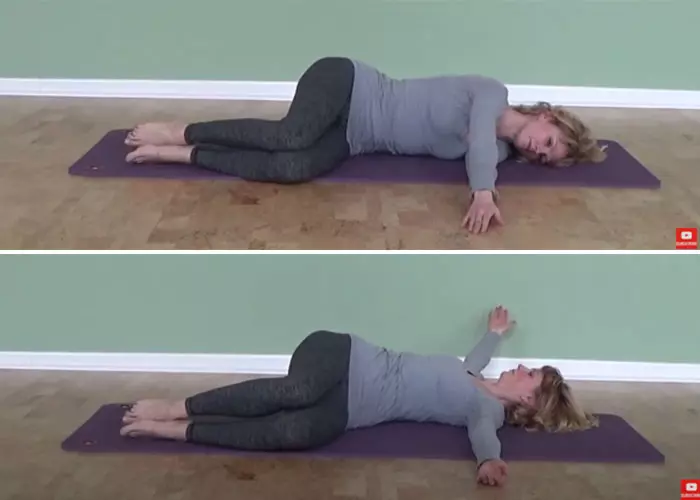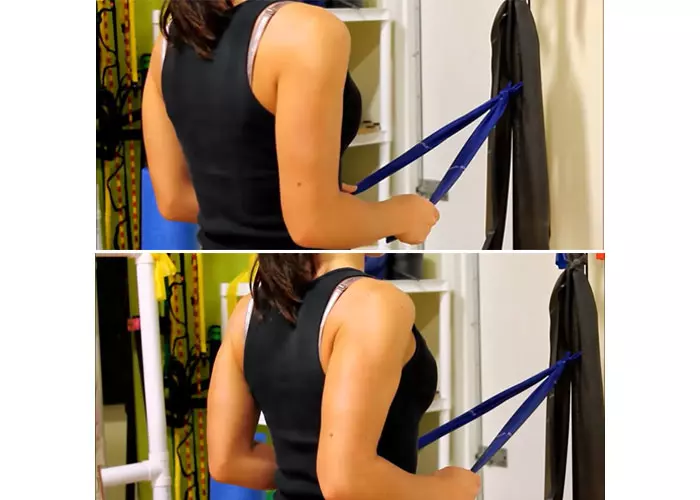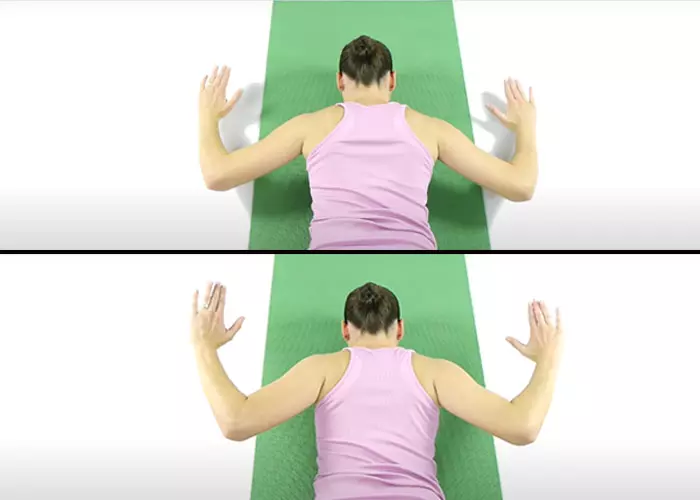Anti-inflammatory medications and physical therapy exercises help counteract shoulder impingement and improve hand movement. In this post, experts talk about shoulder impingement, its causes and diagnosis, and 11 exercises that can help. Scroll down!
What Is Shoulder Impingement?
Shoulder impingement is a painful condition of the shoulder joint. It results in the physical and mechanical ‘pinching’ of a structure within the shoulder joint. Stephanie Carter Kelley, Ph.D. and a board-certified specialist in Orthopedic PT, says, “Pain typically occurs in the front aspect or deep within the shoulder as someone reaches overhead or across the body.” She explains that the main soft tissue structures pinched are: A total of 464 individuals were included in a study that analyzed the prevalence of rotator cuff tendon tears and symptoms and their association with pain. The prevalence of tendon tears was 22.2%, while 8.9% had seen their general physician with shoulder pain and a rotator cuff tear, 18.8% with shoulder pain and an abnormal tendon, and 29.3% with shoulder pain. To understand shoulder impingement and treat it, knowing what causes it is important. Scroll down for a list of factors that can cause shoulder impingement.
What Causes Shoulder Impingement?
Spatial Issue: Mechanical narrowing of the space above the ball-and-socket joint is a common cause of shoulder impingement (1). Poor Posture: Rounded upper back, shoulder blades positioned forward and tipped downward, and upper arm rotated inward. Stiffness: Loss of motion at any of the joints along the chain of the shoulders. Dr. Jordan Duncan, DC, says, “Decreased mobility of the thoracic spinei The middle section of the spine that starts at the base of the neck and ends at the bottom of the ribs. can also cause shoulder impingement.” Shoulder Instability: Injury typically causes abnormal motion of the shoulder.
Muscle Weakness: Weakness in muscles that support and move the shoulder blade and rotator cuff muscles (group of four muscles that enable shoulder and hand movements).
Overactive Muscles: The upper trapeziusi Broad, triangular, and thin muscles that cover the upper back of the shoulders, neck and trunk. muscles can become overactive when a person is triggered into “fight or flight” by stress or fear. These muscles run along the sides of the neck out to the top of the shoulders. According to Stephanie Carter Kelley, Ph.D., “Tension you feel all day along the sides of your neck and chronic low-level stress causes shoulders to creep up to your ears by way of upper trapezius activity. When the upper traps are overactive, they ‘take over’ the movement of reaching overhead and don’t allow the supportive muscles to properly coordinate the complex movements.”
Your doctor will run a few tests to confirm shoulder impingement. Find out which tests are required in the section below.
How To Diagnose Shoulder Impingement
Dr. Jerome G. Enad, MD, says, “An evaluation by a shoulder specialist, sports medicine specialist, or a physical therapist is usually needed to accurately diagnose the occurrence and type of impingement. The diagnosis can typically be made with a hands-on evaluation and X-rays. Sometimes, an MRI is needed, but not always.” Dr. Robert W. Berghorn, Jr., DPT, ATC, USAW, explains the diagnosis process. He says, “I take my patients through a detailed question and answer portion first. From there, we find out what activities or movements bother the shoulder. Next, we go into a very detailed physical exam that includes motion testing, strength testing, and special tests.” The two tests that doctors perform are (2): Depending on the severity of the pain and the condition, doctors may recommend anti-inflammatoryi The property of a drug that helps reduce inflammation in the body as well as redness and pain. medications and exercise therapy (under the supervision of a licensed physical therapist). The following section lists 11 exercises to rehabilitate the shoulder impingement syndrome. Take a look!
11 Shoulder Impingement Exercises To Reduce Pain
Apply a hot water bag to prep the muscles before starting the exercises. Start with fewer reps and increase them gradually. You can even add weights. Apply an ice pack after you complete the exercises. Dr. Jerome G. Enad, MD, advises “one should not ‘push through’ any fatigue or pain in the shoulder.” Let your physical therapist know if you experience pain and discomfort while exercising. With these points in mind, let’s begin with the shoulder impingement exercises.
1. Wall Slides
Steps
2. Shoulder Scaption
Steps
3. Posterior Capsular Stretch
Steps
4. Side-Lying External Rotation
Steps Note: If holding a 1-pound weight causes discomfort, do this shoulder strengthening exercise without weights for a while. Instead of a dumbbell, you can also use low-resistance therapy bands. This is a great rotator cuff exercise that reduces shoulder pain and increases your mobility.
5. Internal Rotation
Steps Note: It is also an ideal shoulder labral tear exercise. It relieves the pain gradually.
6. Levator Scapulae Stretch
Steps
7. Open Books
Steps
8. Standing Rows
Steps
9. Pectoral Stretch
Steps Note: Don’t do this stretch if it hurts.
10. Shoulder W
Steps
11. Thoracic Extension Stretch
Steps These are the 11 exercises you can do to relieve pain due to shoulder impingement. However, it is best to do them after consulting an orthopedic doctor and under the supervision of a licensed physical therapist.
What Kind Of Physical Therapist Can Help?
Board-certified orthopedic surgeon Dr. Jerome G. Enad, MD, advises that contacting a physical therapist experienced in shoulder and joint mobilizations can help treat shoulder impingement. Stephanie Carter Kelley, Ph.D. and a board-certified specialist in orthopedic physical therapy, recommends a physical therapist certified in orthopedics or sports. Upon examining the pain history and movements, they will provide therapeutic exercises you can perform in the clinic or at home. Diane Harper, a swimmer and a blogger, shares her experience of going through shoulder pain and how she overcame it. She was initially apprehensive about the mobility exercises. However, she says, “I’m learning the importance of doing all the exercises I am given, so I can go from sad little Karen Gorney arms to a full John Travolta stretch (i).” Learn the best way to exercise to help relieve shoulder impingement syndrome. Watch this informative video for tips on the best exercises and how to do them correctly. How long does it take for shoulder impingement to heal? Generally shoulder impingement heals within 3 to 6 months, with the possibility of return to regular activities within 2 to 4 weeks. However, severe shoulder impingement may take years to heal fully. What does an impinged shoulder feel like? Individuals with an Impinged shoulder may feel stiffness, swelling and a throbbing sensation. Is massage good for shoulder impingement? Yes, massage therapy may facilitate shoulder impingement healing and reduce pain and inflammation associated with the condition. Which exercise to avoid during shoulder pain? Weightlifting, swimming, and throwing weights or balls should be avoided during shoulder pain.
